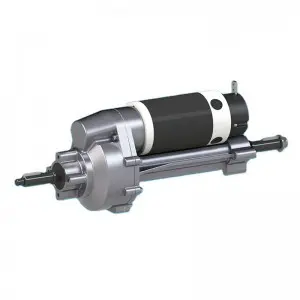introduce:
When talking about cars, we often hear the terms “transaxle” and “transmission” used interchangeably. However, there are distinct differences between the two, and understanding these components is important to understanding their role in vehicle function. In this blog, we will explore the key differences between transaxles and transmissions to help you gain a deeper understanding of these important automotive components.
Transaxle and Transmission Definitions:
Let’s first define these two terms. The transmission is the vital mechanical component responsible for transferring power from the engine to the wheels of the vehicle. It consists of multiple gears for smooth shifting and efficient power transfer. A transaxle, on the other hand, is a special type of transmission that combines the variator and differential into one unit.
Transaxle: Combined Transmission and Differential:
Traditionally, the gearbox is separate from the differential, which distributes power evenly between the two wheels for easier cornering. However, in a transaxle, both components are integrated into a single unit. This combination saves weight and helps optimize the vehicle’s balance and handling characteristics. Transaxles are typically used in front-engine, front-wheel-drive vehicles, or mid-engine cars, while transmissions can be used in a variety of applications, including front-wheel-drive, rear-wheel-drive, or all-wheel-drive setups.
Differences in design and functionality:
Structurally, a transaxle and a transmission may look very similar since they both contain gears and shafts. However, the main difference is their positioning within the vehicle. The gearbox is usually located behind the engine, while the transaxle fits between the engine and the drive wheels.
Functionally, the transaxle plays a vital role in combining the functions of the transmission and differential. While the transmission is solely focused on changing gears to provide different gear ratios, the transaxle also distributes power evenly between the front wheels, enhancing traction and control during acceleration and cornering maneuvers.
pros and cons:
There are several advantages to using a transaxle. First, it simplifies the drivetrain layout, which improves weight distribution and handling. Second, transaxles allow for better packaging options, which is an advantage in vehicles with limited space, such as sports cars. Additionally, fewer components are required, which reduces maintenance costs and increases reliability.
However, there are also some disadvantages to consider. Since a transaxle combines the transmission and differential, it means that if one component fails, the entire unit may need to be replaced, potentially resulting in higher repair costs. Additionally, due to its compact design, a transaxle can reach the limit of its thermal capacity faster than a standard transmission, which can lead to overheating issues if not managed properly.
in conclusion:
Although the terms “transaxle” and “transmission” are sometimes used interchangeably, they refer to different components within a car. A transmission is a separate unit responsible for shifting gears, while a transaxle is a combination of a transmission and a differential, present in a specific vehicle configuration. Knowing their differences will enable you as a vehicle owner to make informed decisions when it comes to maintenance and repairs.
Post time: Jun-24-2023


